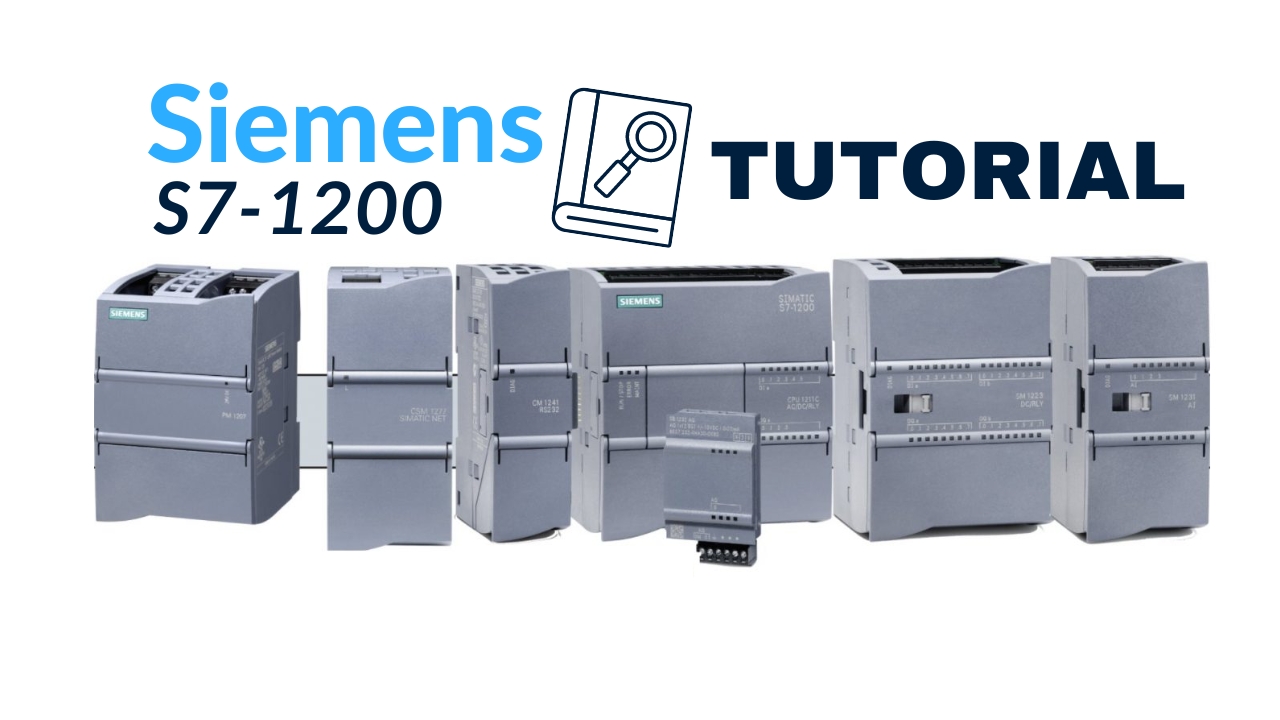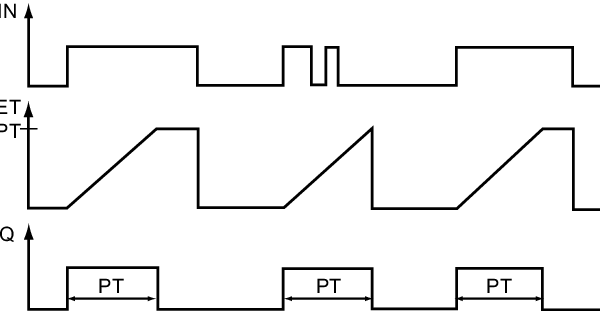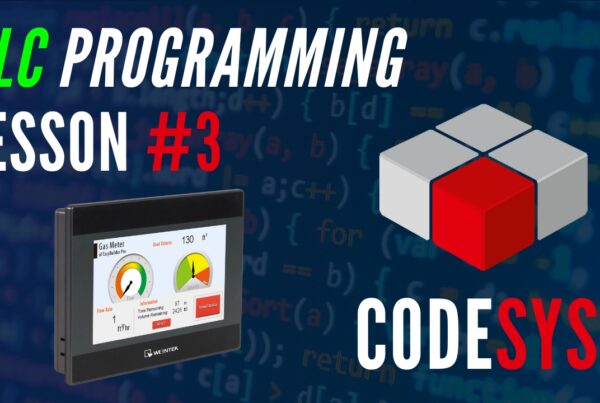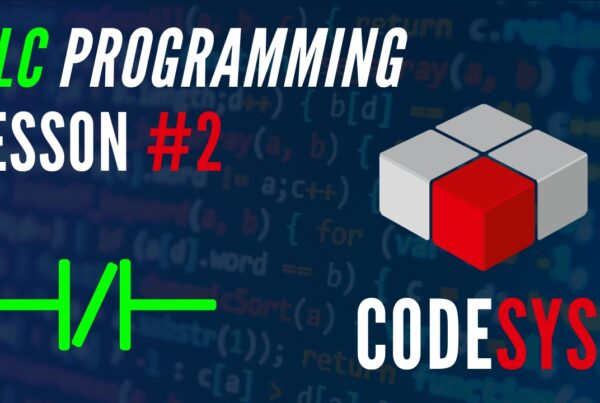“Welcome to the world of automation, young one… here every little detail matters” – this is the sentence I heard at the beginning of my journey with automation and PLCs.
It quickly became my motto!
Working with industrial automation requires precision, and every, even the smallest mistake, can have enormous consequences.
That’s why understanding how PLCs work, for example, those like the Siemens S7-1200, is crucial.
In this article, I will introduce you to the basics of the Siemens S7-1200 PLC. I’ll discuss its structure, functions, and capabilities so that you can effectively use it in your projects.
No matter whether you’re just starting your adventure with automation or looking for additional knowledge – this guide will help you take your first steps in the world of industrial automation solutions, where every detail matters!
Let’s get started!

Siemens S7-1200 PLC Tutorial Outline:
What is the Siemens S7-1200 PLC?
It is a series of PLCs manufactured by the giant, Siemens. Like all other PLCs, they are used in various industries, from oil refineries, production lines, conveyor systems, to building automation systems.
Different CPU units and their differences
The S7-1200 series is divided into many models with different parameters and applications. Below are some of the models and their parameters:

They mainly differ in:
- enclosure size
- memory
- number of inputs/outputs
- expandability
- number of HSC (High-Speed-Counter) inputs
- number of HSO (High-Speed-Output) outputs


Expansion modules for Siemens S7-1200 PLC
Each CPU unit can be expanded with expansion modules, of which there are 3 types – as seen in the graphic above. It’s important to match the size of the controller to the location where you intend to use it because even individual CPU units differ in size.

- Power Supply dedicated for the S7-1200 PLC
- Network Switch in case the number of Ethernet ports is insufficient
- Communication Module e.g., IO-Link, RS422/485, Profibus or CAN
- CPU, in other words, the PLC Siemens S7-1200 unit
- Technology Modules, such as weighing modules or energy measurement modules
- IO Modules, for increasing the number of digital and analog inputs/outputs
- Expansion Cards, e.g., adding a few high-speed inputs and outputs
In the example below – the S7-1200 controller is expanded with an IO-Link SM1278 technology module, used for communication with the inverter.

Remember that when choosing the Siemens S7-1200 PLC, you must be aware that the number of modules you can connect to the CPU depends on the version of the controller you have – I explain this later in the article.
External structure of the Siemens S7-1200 PLC CPU

Key elements of the S7-1200 PLC
- Terminal blocks
- Status LEDs for CPU and I/O
- PROFINET connector
- Slot for expansion cards
- Memory card slot

Internal structure of the Siemens S7-1200 CPU
Below you can find a few pictures for electronics enthusiasts who want to dive into automation. See how the S7-1200 controller looks inside!


The Siemens S7-1200 PLC features a three-layer, stacked construction, with each board serving a specific role. Here’s a refined description of the individual layers:
- Power Board (bottom layer): This board houses components responsible for the controller’s power system. It includes all the necessary elements for voltage stabilization and power supply to the upper layers. While this board doesn’t have a direct power connection, the key elements responsible for processing and supplying power to the rest of the controller are located here.
- Middle Board (expansion module): Here, you’ll find the power connector, where the external power source is connected. In addition to the power connector, this layer also supports I/O connections, enabling the connection of peripheral devices such as sensors, actuators, and other automation system components. This board also contains relays and optoisolators that protect the signals.
- CPU Board (top layer): The most important board, containing the main processor (CPU), responsible for executing the control program and managing the device’s overall operation. This board also houses the Ethernet connector, allowing communication with other devices in the industrial network. The processor communicates with the other layers, controlling data and signal flow.



Versions of the Siemens S7-1200 PLC CPU
Below you will find 19 versions of the S7-1200 PLC.
How to decipher the designation, e.g., AC/DC/RLY?
The AC/DC/RLY designation might seem unclear at first, but I will explain. The controller I’m referring to can be powered by 230V AC mains voltage – hence AC in the first position. DC in the second position indicates the type of digital inputs – transistor 24V DC, and RLY at the end means that your controller is equipped with relay outputs.
The controllers surrounded by yellow rectangles mean they come with a built-in safety module, meaning there is no need to use additional safety controllers or relays.
This is how Siemens marks its PLC models.

Sizes of individual S7-1200 PLC models
The individual versions also differ in size. Exact dimensions are provided in the graphic below.

Parameters of the S7-1200 PLCs
The controllers differ not only in size and the way the CPU, inputs, and outputs are powered but also in many other parameters, such as the number of inputs/outputs, memory, and expansion capabilities.
| CPU | CPU 1211C | CPU 1212C | CPU 1214C | CPU 1215C | CPU 1217C | CPU 1212FC | CPU 1214FC | CPU 1215FC |
|---|---|---|---|---|---|---|---|---|
| Integrated PROFINET ports | 1 | 1 | 1 | 2 | 2 | 1 | 1 | 1 1 |
| Working memory / Internal memory | 50 KB / 1 MB | 75 KB / 2 MB | 100 KB / 4 MB | 125 KB / 4 MB | 150 KB / 4 MB | 100 KB / 2 MB | 125 KB / 4 MB | 150 KB / 4 MB |
| Integrated digital I/O | 6 DI 4 DO | 8 DI 6 DO | 14 DI 10 DO | 14 DI 10 DO | 10 DI 6 DO 4 DI 1) 4 DO 1) | 8 DI 6 DO | 14 DI 10 DO | 14 DI 10 DO |
| Analog signals | 2 AI | 2 AI | 2 AI | 2 AI 2 AQ | 2 AI 2 AQ | 2 AI | 2 AI | 2 AI 2 AQ |
| Integrated HSC | 6 @100kHz | 6 @100kHz | 6 @100kHz | 6 @100kHz | 3 @100kHz 3 @1MHz | 6 @100kHz | 6 @100kHz | 6 @100kHz |
| Pulse outputs | 4 | 4 | 4 | 4 | 4 | 4 | 4 | 4 |
| Expansion capabilities | 3 – CM 1 – SB | 3 – CM 1 – SB 2 – SM | 3 – CM 1 – SB 8 – SM | 3 – CM 1 – SB 8 – SM | 3 – CM 1 – SB 8 – SM | 3 – CM 1 – SB 2 – SM | 3 – CM 1 – SB 8 – SM | 3 – CM 1 – SB 8 – SM |
Maximum number of modules
As I explained earlier, you need to pay attention to the expansion capability of a given CPU version. The higher the CPU model, the more modules you can attach to it – see the graphic below.

Available Siemens S7-1200 expansion modules on the market
Siemens offers practically every module you can think of, well, except for WiFi 🙂 Below, I’ll show you the expansion possibilities for the S7-1200 CPU.
Input/Output Modules and Technology Modules for Siemens S7-1200

Communication modules for Siemens S7-1200

Siemens S7-1200 PLC communication
The PLC from Siemens offers us a wide range of communication protocols to choose from, allowing us to exchange data with other automation devices. Below is a list of available protocols:
- PROFINET
- PROFIBUS Master / Slave
- OPC UA Server
- AS-i Master
- BACNet Client/Server*
- CANopen Master*
- TCP/IP Protocols (Modbus TCP, MQTT, HTTP, etc.)
- IO-Link Master
- GSM/GPRS/LTE
- DNP3, IEC 60870-5-104
- RFID
- PtP (RS-485, RS-422 & RS232)
- Modbus RTU
- USS Protocol (Universal Serial Interface Protocol)

Integrated PID controllers in the S7-1200 PLC
The S7-1200 controller has advanced integrated PID controllers to automate control processes. With the autotuning function, the system automatically tunes the PID loop parameters, which simplifies tuning and optimizes control.
Users have access to easy-to-configure screens that allow them to quickly deploy and monitor the process in real time, which is especially useful during startup.

Integrated motion control in the S7-1200 PLC
The S7-1200 controller also supports motion control, which includes speed and position control. With integrated support for stepper motors and servo drives, the S7-1200 can control various drive systems using Pulse-Train Output (PTO) or communication protocols such as PROFIdrive (PROFINET/PROFIBUS).

Which license to choose for TIA Portal?
On the slide, we see that Step 7 (TIA Portal) Basic supports S7-1200 and S7-1200 F PLCs and provides support for the PLCSIM simulator and Basic HMI panels. This is the basic version of the software, aimed mainly at these devices.

Other controllers, such as the S7-300 F, S7-400 F, S7-1500 F and the Open Controller and Software Controller, are supported only by Step 7 Professional, which also offers Step 7 Safety Advanced (optional).
Application: Hydraulic press on Siemens S7-1200 PLC

For a machine like a hydraulic press, we’ll need to program devices like these:
- Pressure Sensors: Used to monitor and regulate pressure in the hydraulic system of the press. They ensure constant control over the pressing force, which is crucial for the quality of operations performed.
- Position Sensors: Allow precise determination of the position of the press’s moving parts, such as the piston. They are necessary for precise control of the pressing process and to ensure repeatability of operations.
- Digital Manometers: Used for accurate pressure reading in the hydraulic system. They can be utilized to monitor and record real-time pressure data, allowing for process analysis and optimization.
- HMI Interfaces: Touchscreens or operator panels that allow the user to interact with the machine, set work parameters, visualize processes, and diagnose faults.
- Safety Systems: Including light barriers, safety mats, and emergency stop buttons, designed to protect the operator from injury. These systems are designed to automatically stop the machine in case a dangerous situation is detected.
- Encoders: Devices measuring rotation or position that can be used to precisely control the movement of the piston or other moving parts of the press.
Application: HVAC ventilation system on Siemens S7-1200 PLC

In HVAC systems, with Siemens S7-1200 you will control the following components:
- Thermostats: Allow regulating the room temperature from the controller according to a programmed schedule or based on user behavior.
- Temperature and Humidity Sensors: These monitor conditions in the rooms and are crucial for automatically adjusting HVAC systems to maintain the desired climate conditions.
- Controlled Dampers and Valves: Allow precise control of warm or cold air and water flow in heating and cooling systems, ensuring proper temperature and air distribution throughout different parts of the building.
- Motion Detectors: Can be integrated with HVAC systems to automatically adjust air conditioning settings depending on the presence or absence of people in the room.
- Smart Windows: Using dimming technology or special coatings, these can automatically adjust the amount of sunlight entering a room, affecting its heating and potentially reducing the need for air conditioning.
- Integrated Lighting Systems: Can automatically adjust lighting levels based on the availability of natural light, which also impacts the room temperature.
- Programmable Fans and Pumps: With speed control (e.g., using inverters), they adjust their operation to the current demand, reducing energy consumption.
Application: Drives controlled by Siemens S7-1200 PLC

- AC (Alternating Current) Electric Drives: The S7-1200 can control AC drives via analog or digital signals, using appropriate output modules. Communication protocols like Modbus RTU can also be used to control drives through a serial interface.
- DC (Direct Current) Electric Drives: Similar to AC drives, DC drives can be controlled by direct signals from the PLC or through digital communication.
- Servo Drives: The S7-1200 can control servo drives via analog control signals (for simple position or speed control) or through advanced communication interfaces like Profinet if the drives are equipped with the appropriate communication modules.
- Stepper Motors: The controller can manage stepper motors by using digital output signals for precise control of movement. It is possible to program step sequences directly in the PLC logic.
- Motors with Frequency Converters (Inverters): The S7-1200 can control inverters using analog signals (for speed regulation) or through digital communication, such as Modbus RTU or Profinet, which allows for more complex control, including vector control.
Application: Industrial furnace on Siemens S7-1200 PLC

Here are some of the devices and functions that can be used to control an industrial furnace:
- Temperature Sensors: The most commonly used are thermocouples and RTD (Resistance Temperature Detector) sensors, which measure temperature at various points in the furnace. Data from these sensors are essential for regulating the heating process.
- PID Controllers (Proportional-Integral-Derivative): These are software functions in the PLC that enable precise temperature control in the furnace. They operate based on temperature sensor readings, automatically adjusting the heating power to maintain the desired temperature.
- Heating Element Control: Depending on the furnace type and its heating elements (e.g., resistors, gas burners, induction elements), the PLC can control their operation through relays, contactors, solid-state relays (SSR), or analog output modules to regulate power.
- Ventilation Systems and Blowers: Controlling airflow in the furnace is important for maintaining even temperature distribution and for processes that require a specific atmosphere inside the furnace chamber. The PLC can control the operation of fans and damper valves.
- Time-Based and Sequential Programs: The PLC allows programming of complex furnace operation sequences, including stages of heating, maintaining temperature, and cooling, which is especially important in technological processes such as metal heat treatment or ceramic firing.
- HMI Interfaces: These allow operators to monitor the furnace status, input process settings, start baking programs, and quickly diagnose any problems.
- Alarm and Safety Systems: For monitoring and responding to unusual furnace conditions, such as exceeding the maximum temperature, heating element failure, or ventilation issues. The PLC can automatically shut down the furnace in case of a malfunction, minimizing risks.
- Communication Modules: These enable the integration of the PLC with other systems in the plant, allowing remote monitoring, diagnostics, and process control, as well as data collection for process analysis and optimization.
Application: Pumping station on Siemens S7-1200 PLC

Controlling a water pumping system using a PLC like the Siemens S7-1200 allows automating pumping processes, monitoring pump operation, and optimizing energy consumption. Here are some devices and functions that can be used in a water pumping system:
- Pumps: These are the main devices in a water pumping system. The PLC can control various types of pumps, including submersible pumps, centrifugal pumps, multi-stage pumps, etc., depending on system requirements.
- Inverters (Frequency Converters): These allow adjusting the pump motor’s speed, enabling precise regulation of water flow according to the current system needs. Controlling inverters via the PLC helps optimize energy consumption and reduce mechanical wear on the pumps.
- Flow Sensors: These measure the amount of water being pumped through the system. Data from flow sensors can be used by the PLC to regulate pump operation, ensuring the appropriate water flow.
- Water Level Sensors: These are used to monitor water levels in tanks, wells, or other reservoirs. The PLC can automatically start or stop pumps depending on the water level, preventing overfilling or emptying of tanks.
- Valves: The PLC can control valves in the system to regulate water flow, direct water to different parts of the system, or isolate parts of the system for maintenance or in the event of a failure.
- HMI Interfaces: These provide easy monitoring and control of the water pumping system by operators. They can display important information such as current flow, water level, pump status, alarms, and allow manual system control.
- Alarm Systems: The PLC can monitor the system for abnormalities, such as dry-running pumps, high/low water pressure, pump failures, etc., and generate alarms or automatically take corrective action.
- Programmable Operating Sequences: The PLC allows programming automatic operation sequences, such as cyclical water pumping, automatic pump switching in case of a failure, or controlling cleaning and disinfection processes in water treatment systems.
Siemens S7-1200 PLC Tutorial Outline:
S7-1200 PLC applications in various market segments
OEM
- Conveyors
- Elevators
- Material handling machines
- Metalworking
- Packaging
- Printing
- Textiles
- Mixers
- AGVs (Automatic Guided Vehicles)
Remote communication
- Pick and place applications
- Stacking machines
- Conveyors
- Dispensers
- Material handling
- Packaging
- Printing
- Textiles
- Welding
Motion control
- Boiler control
- Cooling tower control
- Energy management
- Fire protection
- HVAC
- Lighting control
- Pump control
- Security access
- Transportation
- Irrigation
- Garage doors
- Car washes
- Bowling alleys
- Traffic control
Infrastructure
- Wastewater treatment plants
- Oil/gas pump stations
- Petrochemical gas pump stations
- Electricity distribution
How to learn Siemens S7-1200 PLC programming language?
You can program the Siemens S7-1200 controller in two main languages: graphic LADDER and text SCL. We have prepared a course especially for you, which is intended for beginners and advanced users.
First you can try learn from this free Siemens PLC training.
If you like the entry course, we invite you to the full training! The course goes step by step from the basics to advanced topics. click on the link below and find out more!




